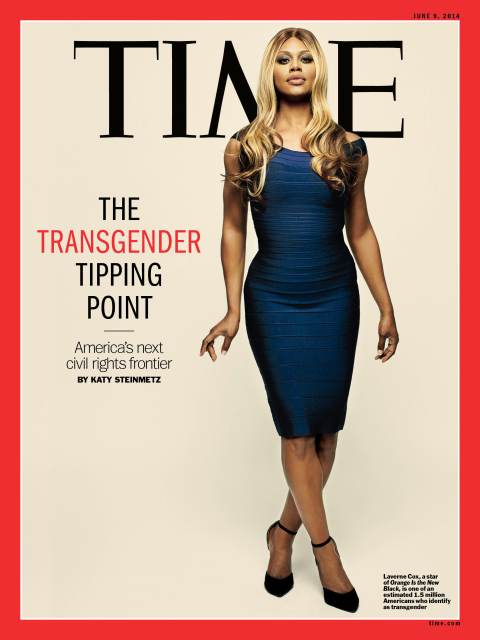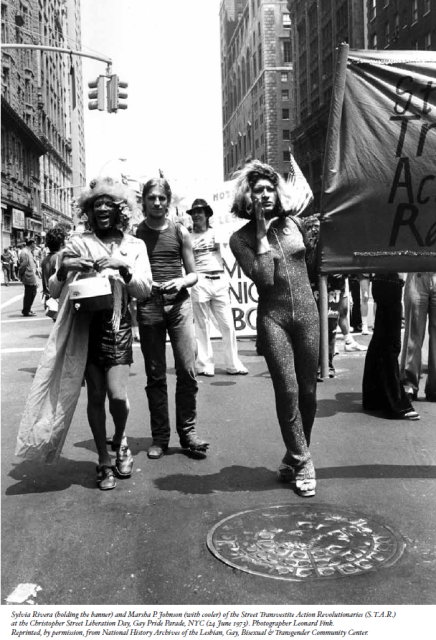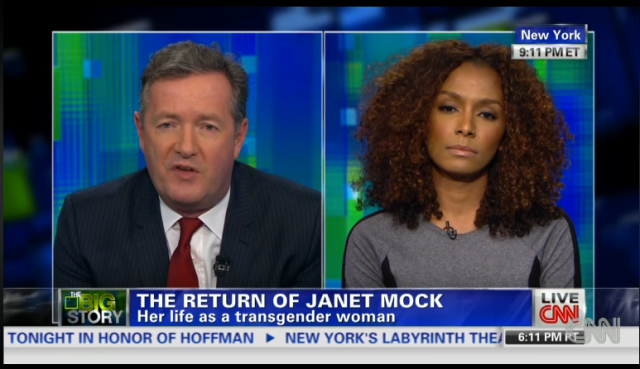A month after being one of the top vote-getters in Time Magazine’s online poll for their annual “Person of the Year” issue and then being subsequently left completely out of that issue, actress and transgender rights activist Laverne Cox has leapt completely past the idea of being one person in a giant list of the year’s most important people and has secured the entire cover for herself. This cover goes along with Time’s story, titled, “The Transgender Tipping Point,” and makes Cox the first ever openly transgender person to grace the cover of the magazine.

First off, I just want to celebrate Cox’s accomplishment. This is a big day for Cox, for all trans people, for trans women, and for trans women of color. Being on the cover of Time Magazine is a huge honor and I want to stand up and applaud Cox for accomplishing so much that Time couldn’t help but notice her.
When I saw that Cox was on the cover I was so happy and proud. I think that it’s awesome that so many of the leading faces in the current trans movement are trans women of color (Janet Mock, CeCe McDonald and Carmen Carrera) and Cox is another example of that, and this is another example of the great couple of years she’s been having. However, when I heard the premise of the article, some of that excitement turned to trepidation. The cover calls the transgender movement “America’s Next Civil Rights Frontier.” This is problematic on multiple levels.

First of all, it makes it seem like we are done fighting for other civil rights, when it has Cox, a black trans woman, who is discriminated against not only because she is trans, but also because she is black and a woman. Also, the fight for trans rights isn’t exactly new. What many see as the genesis of the modern Gay Rights Movement was started by trans women of color. I really want to be happy that we’re getting attention for such an important issue and such a great possibility model like Cox, but I can’t help but think, what if back when Miss Major, Marsha P. Johnson and Sylvia Rivera started the modern Gay Rights Movement at Stonewall, people looked at them and took them and their needs and demands seriously? How far advanced would we be today?
Then there’s the actual content of the piece. This article is written so problematically that I had to actually stop reading it at several points. In the cover story by Katy Steinmetz, the writer positions this “new civil rights frontier” as coming one year after the Supreme Court ruled in favor of gay marriage, which, I guess, was when the Gay Rights Movement was won.
She then talks about trans people “emerging from the margins” to fight for rights, I agree that it does look like more trans people are being given spotlights and microphones in order to tell their stories, but we weren’t the ones who put ourselves on the margins. Sylvia Rivera was shouting at the top of her lungs about trans women’s rights decades ago when the mainstream Gay Rights Movement shoved her, and other trans women of color, under the bus and off of the stage.

The article says “This article will use the names, nouns and pronouns preferred by individuals, in accordance with Time’s style” but then goes on to use “him” to describe a trans woman and Christine Jorgensen’s birth name in the very same paragraph. That wasn’t the last time they would use incorrect names or pronouns.
They even give an entire paragraph to the anti-science, anti-logic, anti-human-decency opinion of people who “don’t believe in” the concept of gender identity. Why do we need to give a voice to someone who asks “Can I claim to be an African American if I feel African American?” (The answer is: we don’t.)
In another paragraph they explain how gender and sex are different, and how understanding this is how we are able to understand trans people. They say “sex is biological, determined by a baby’s birth anatomy; gender is cultural, a set of behaviors learned through human interaction.” Then later, when talking about trans people taking hormones, they use “biological females” when talking about trans men and “biological males” when talking about trans women. Calling trans women males is not a good way to explain us to people who don’t understand, it’s a good way to misgender us and reinforce the idea that we’re not “real women.”
Saying that it’s a “baby’s birth anatomy“ that determines sex, and not even an adult’s anatomy (which is already plenty simplistic and misguided and superficial and leaves out a lot of factors) is extremely frustrating and damaging to the trans cause. They even have a quote from Mara Keisling at the National Center for Transgender Equality about how focusing on genitalia is “maddening for (trans people)” and shouldn’t be the focus of discussions about us. After this article call trans women “biological males” how are we supposed to take their dedication to helping trans people seriously?

Then, when discussing Janet Mock, who famously was misgendered and treated extremely poorly on the Piers Morgan show just a few months ago, they use her birth name. Do they really have to keep doing that? Did they not learn that she doesn’t appreciate that kind of thing?
Time also has a video showing Cox talking about trans issues that is, in my opinion, a lot better than the article. In it, and in the interview that is transcribed on the same page, Cox is able to shine, because she is able to control the narrative (which is something she talks about being important in the interview) instead of having it being written by a cis person. Cox is able to wonderfully sum up how cis people can best help trans people.
A lot of it is just listening to transgender people and taking the lead from trans folks. The reality is that I don’t represent the entirety of the trans community… and so it’s really about listening to individuals… and taking people at their word. When we look at the discrimination that transgender people face there tends to be intersections of race and class. The homicide rate, for example, in the LGBTQ community is highest among trans women and then when we look at trans women who are being victims of violence most its usually trans women of color… I think the trans movement, and the LGBT movement in general, really has to be a social justice movement where we look at issues of race and class and phobia…

I really, really hate that so often when I write about the media’s coverage of trans people I’m writing from a place of anger or pain. I wanted to just be able to write something celebrating Laverne Cox and her accomplishment. She is killing it right now and deserves to have people write positive articles about her. I really wished that I could’ve just celebrated her being on the cover, but reading this article was frustrating and difficult and reminded me that even “allies” still often see me as male.
I can tell that this story was coming from a place that’s trying to do good – and for much of the article, I think they do just that. Having the cover story in Time means that a lot of people will become aware of a whole slew of trans issues that they probably otherwise wouldn’t have heard about. However, if an article talking about the positive strides the trans movement is making gets so much wrong, how much worse are other articles going to be? I’m glad that Time featured Cox on their cover, but I do not appreciate them using trans women’s birth names and calling Cox, me and every other trans woman a male.
Still, let’s take a moment to applaud and appreciate Laverne Cox; heck, let’s take a whole bunch of moments. She deserves every bit of praise that is being heaped on her. She’s on the cover of motherfreaking Time Magazine.







